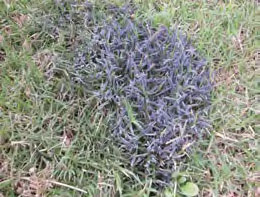Slime Mold: The Blob on the Lawn
What is that slimy blob in my yard?! 
Searcy, Ark. –
After an extended period of heavy rain, an organism known as slime mold may appear in your lawn. Slime mold takes many forms. The most common forms on turf resemble small purple or black balls attached to a blade of grass, or a readily noticeable creamy‑white to yellow‑orange jelly‑like mass situated on the lawn. Slime mold must have been the inspiration for many "B" grade monster movies.
What is slime mold?
Slime mold is a primitive organism that has properties of both an amoeba and a fungus. The slime mold produces spores that are capable of amoeba‑like movement. The motile spores feed on fungi, bacteria, and other micro‑organisms and decaying organic matter.
 The slime mold spores consume food by simply engulfing particles as they move. The
single cell spores multiply by division. The spores pair off and become a shapeless
slimy mass, which may flow to the soil surface. Movement of the slimy mass is encouraged
by moist cool conditions. The slimy mass flows on to low‑lying but upright objects
such a blades of grass and garden walls. Once the slime mold mass is located on an
upright object, it produces fruiting bodies that produce new spores.
The slime mold spores consume food by simply engulfing particles as they move. The
single cell spores multiply by division. The spores pair off and become a shapeless
slimy mass, which may flow to the soil surface. Movement of the slimy mass is encouraged
by moist cool conditions. The slimy mass flows on to low‑lying but upright objects
such a blades of grass and garden walls. Once the slime mold mass is located on an
upright object, it produces fruiting bodies that produce new spores.
Will slime mold hurt my lawn?
Slime mold for the most part is a beneficial organism that decays dead plant material, returning nutrients to the soil. It is not a disease, but turf that has been shaded by slime mold may be more susceptible to turf diseases.
How do I get rid of slime mold?
Chemical control is usually not necessary. Raking up and disposing of the slime mold is usually all that is required.
The slime mold will go away in warm‑dry weather conditions.
For more information, check out our publication on slime mold in the home landscape.
By Sherri Sanders
County Extension Agent - Agriculture
White County Extension Agent - Agriculture
U of A Division of Agriculture
Cooperative Extension Service
2400 Old Searcy Landing Road Searcy AR 72143
(501) 268-5394
ssanders@uada.edu